CHAPTER XII.
 S we passed the foot of Cro' Nest, we caught pleasant glimpses of West Point,
where the government of the United States has a military school, and in a
few moments the whole outline of the promontory and the grand ranges of hills
around and beyond it, was in full view. We landed in a sheltered cove a little
above Camp Town, the station of United States troops and other residents at
the Point, and climbed a very steep hill to the Cemetery upon its broad and
level summit, more than a hundred feet above the river. It is a shaded, quiet,
beautiful retreat, consecrated to the repose of the dead, and having thoughtful
visitors at all hours on pleasant days.
S we passed the foot of Cro' Nest, we caught pleasant glimpses of West Point,
where the government of the United States has a military school, and in a
few moments the whole outline of the promontory and the grand ranges of hills
around and beyond it, was in full view. We landed in a sheltered cove a little
above Camp Town, the station of United States troops and other residents at
the Point, and climbed a very steep hill to the Cemetery upon its broad and
level summit, more than a hundred feet above the river. It is a shaded, quiet,
beautiful retreat, consecrated to the repose of the dead, and having thoughtful
visitors at all hours on pleasant days.
"There, side by side, the dark green cedars cluster,
Like sentries watching by that camp of though;
There, like an army's tents, with allow-white lustre,
The grave-stones gleam beneath.
"Few are the graves, for here no populous city
Feeds, with his myriad lives, the hungry Fate;
While hourly funerals led by grief or pity,
Crowd through the open gate.
"Here sleep brave men, who, in the deadly quarrel,
Fought for their country, and their life-blood poured;
Above whose dust she carves the deathless laurel,
Wreathing the victor's sword.
"And here the young cadet, in manly beauty,
Borne from the tents which skirt those rocky banks,
Called from life's daily drill and perilous duty
To these unbroken ranks."
The most conspicuous object in the Cemetery is the Cadet's Monument, situated at the eastern angle. It is a short column, of castle form, composed of light brown hewn stone, surmounted by military emblems and a foliated memorial urn, wrought from the same material. It was erected in the autumn of 1818, to the memory of Vincent M. Lowe, of New York, by his brother cadets. He was accidentally killed by the discharge of a cannon, on the 1st of January, 1817. The names of several other officers and cadets are inscribed upon the monument, it having been adopted by the members of the institution as "sacred to the memory of the deceased" whose names are there recorded.
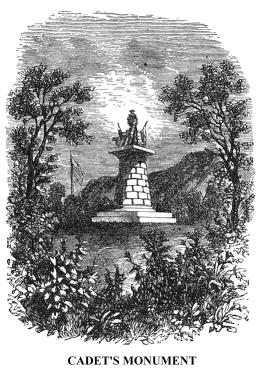 From the brow of the hill, near the Cadet's Monument, is a comprehensive view
of the picturesque village of Cold Spring, on the east side of the river,
occupying a spacious alluvial slope, bounded by rugged heights on the north,
and connected, behind a range of quite lofty mountains, with the fertile valleys
of Duchess and Putnam Counties. We shall visit it presently. Meanwhile let
us turn our eyes southward, and from another point on the margin of the Cemetery,
where a lovely shaded walk invites the strollers on warm afternoons, survey
Camp Town at our feet, with West Point and the adjacent hills. In this view
we see the Old Landing-place, the road up to the plateau, the Laboratory buildings,
the Siege Battery, the Hotel, near the remains of old Fort Clinton, upon the
highest ground on the plain, the blue dome
From the brow of the hill, near the Cadet's Monument, is a comprehensive view
of the picturesque village of Cold Spring, on the east side of the river,
occupying a spacious alluvial slope, bounded by rugged heights on the north,
and connected, behind a range of quite lofty mountains, with the fertile valleys
of Duchess and Putnam Counties. We shall visit it presently. Meanwhile let
us turn our eyes southward, and from another point on the margin of the Cemetery,
where a lovely shaded walk invites the strollers on warm afternoons, survey
Camp Town at our feet, with West Point and the adjacent hills. In this view
we see the Old Landing-place, the road up to the plateau, the Laboratory buildings,
the Siege Battery, the Hotel, near the remains of old Fort Clinton, upon the
highest ground on the plain, the blue dome 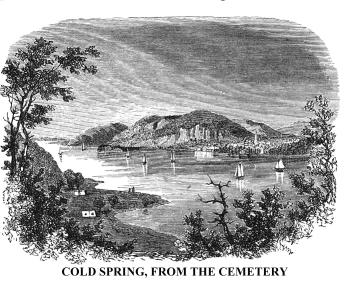 of
the Chapel, the turrets of the great Mess Hall, on the extreme right, the
Cove, crossed by the Hudson River Railway, and the range of hills on the eastern
side of the river.
of
the Chapel, the turrets of the great Mess Hall, on the extreme right, the
Cove, crossed by the Hudson River Railway, and the range of hills on the eastern
side of the river.
Following this walk to the entrance gate, we traverse a delightful
winding road along the river-bank, picturesque at every turn, to the parting
of the ways. One of these leads to the Point, the other up Mount Independence,
on whose summit repose the grey old ruins of Fort Putnam. We had ascended
that winding mountain road many times before, and listened to the echoes of
the sweet bugle, or the deeper voices of the morning and evening gun at the
Point. Now we were invited by a shady path, and a desire for novelty, from
the road between Forts Webb and Putnam, into the deep rocky gorge between
Mount Independence and the more lofty Redoubt Hill, to the rear of the old
fortress, where it wears the appearance of a ruined castle upon a mountain
crag. The afternoon sun was falling full upon the mouldering ruin, and the
chaotic mass of rocks beneath it; while the clear blue sky and white clouds
presented the whole group, with accompanying evergreens, in the boldest relief.
Making our way back, by another but more difficult path, along the foot of
the steep acclivity, we soon stood upon the broken walls of Fort Putnam, 500
feet above the river, with a scene before us of unsurpassed interest and beauty,
viewed in the soft light of the evening sun. At our feet lay the promontory
of West Point, with its 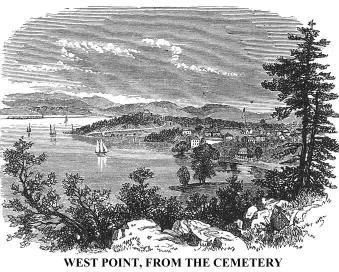 Military
Academy, the quarters of the officers and the cadets, and other buildings
of the institution. To the left lay Constitution Island, from a point of which,
where a ruined wall now stands, to the opposite shore of the main, a massive
iron chain was laid upon floating timbers by the Americans, at the middle
of the old war for independence. Beyond the island arose the smoke of the
furnaces and forges, the spires, and the roofs of Cold Spring. Toward the
left loomed up the lofty Mount Taurus, vulgarly called Bull Hill, at whose
base, in the shadow of a towering wall of rock, and in the midst of grand
old trees, nestles Under Cliff, then the home of Morris, whose songs have
delighted thousands in both hemispheres. On the extreme left arose old Cro'
Nest; and over its right shoulder lay the rugged range of Break Neck, dipping
to the river sufficiently to reveal the beautiful country beyond, on the borders
of Newburgh Bay. This is one of the most attractive points of view on the
Hudson.
Military
Academy, the quarters of the officers and the cadets, and other buildings
of the institution. To the left lay Constitution Island, from a point of which,
where a ruined wall now stands, to the opposite shore of the main, a massive
iron chain was laid upon floating timbers by the Americans, at the middle
of the old war for independence. Beyond the island arose the smoke of the
furnaces and forges, the spires, and the roofs of Cold Spring. Toward the
left loomed up the lofty Mount Taurus, vulgarly called Bull Hill, at whose
base, in the shadow of a towering wall of rock, and in the midst of grand
old trees, nestles Under Cliff, then the home of Morris, whose songs have
delighted thousands in both hemispheres. On the extreme left arose old Cro'
Nest; and over its right shoulder lay the rugged range of Break Neck, dipping
to the river sufficiently to reveal the beautiful country beyond, on the borders
of Newburgh Bay. This is one of the most attractive points of view on the
Hudson.
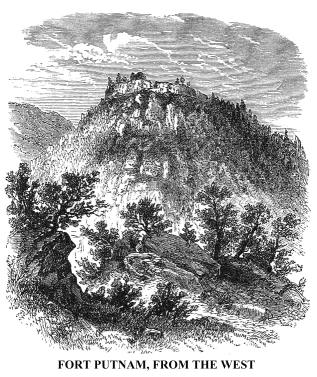 Fort Putnam was erected by the Americans in 1778, for the purpose of defending
Fort Clinton, on West Point below, and to more thoroughly secure the river
against the passage of hostile fleets. It was built under the direction of
Colonel Rufus Putnam, and chiefly by the men of his Massachusetts' regiment.
It commanded the river above and below the Point, and was almost impregnable,
owing to its position. In front, the mountain is quite steep for many yards,
and then slopes gently to the plain; while on its western side, a perpendicular
wall of rock, fifty feet in height, would have been presented to the enemy.
Redoubts were also built upon other eminences in the vicinity. These being
chiefly earth works, have been almost obliterated by the action of storms;
and Fort Putnam was speedily disappearing under the hands of industrious neighbours,
who were carrying off the stone for building purposes, when the work of demolition
was arrested by the Government. Its remains, consisting of only broken walls
and two or three arched casemates, all overgrown with vines and shrubbery,
are now carefully preserved. Even the cool spring that bubbles from the rocks
in its centre, is
Fort Putnam was erected by the Americans in 1778, for the purpose of defending
Fort Clinton, on West Point below, and to more thoroughly secure the river
against the passage of hostile fleets. It was built under the direction of
Colonel Rufus Putnam, and chiefly by the men of his Massachusetts' regiment.
It commanded the river above and below the Point, and was almost impregnable,
owing to its position. In front, the mountain is quite steep for many yards,
and then slopes gently to the plain; while on its western side, a perpendicular
wall of rock, fifty feet in height, would have been presented to the enemy.
Redoubts were also built upon other eminences in the vicinity. These being
chiefly earth works, have been almost obliterated by the action of storms;
and Fort Putnam was speedily disappearing under the hands of industrious neighbours,
who were carrying off the stone for building purposes, when the work of demolition
was arrested by the Government. Its remains, consisting of only broken walls
and two or three arched casemates, all overgrown with vines and shrubbery,
are now carefully preserved. Even the cool spring that bubbles from the rocks
in its centre, is 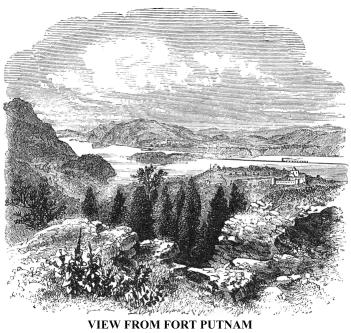 kept
clear of choking leaves; and we may reasonably hope that the ruins of Fort
Putnam will remain, an object of interest to the passing traveler, for more
than a century to come.
kept
clear of choking leaves; and we may reasonably hope that the ruins of Fort
Putnam will remain, an object of interest to the passing traveler, for more
than a century to come.
The winding road from the fort to the plain is quite steep much
of the way, but is so well wrought that carriages may safely traverse it;
and the tourist is led by it to one of the loveliest of river and mountain
views northward from the Point, in front of the residences of Mr. Weir, the
eminent artist, and other professors employed in the Military Academy. Passing
along the shaded walk in front of these mansions, on the margin of a high
bank, a white marble obelisk is seen upon a grassy knoll on the left, shooting
up from a cluster of dark evergreen trees. It was erected by Major-General
Jacob Brown, of the United States army, in 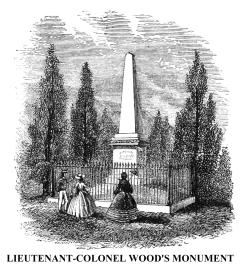 memory
of his youthful and well beloved companion-in-arms, Lieutenant-Colonel E.
D. Wood, of the corps of Engineers, who fell while heading a charge, at the
sortie of Fort Erie, in Upper Canada, on the 17th of September, 1814. He had
been a pupil of the Military Academy at West Point. "He was," says
one of the inscriptions, "exemplary as a Christian, and distinguished
as a soldier."
memory
of his youthful and well beloved companion-in-arms, Lieutenant-Colonel E.
D. Wood, of the corps of Engineers, who fell while heading a charge, at the
sortie of Fort Erie, in Upper Canada, on the 17th of September, 1814. He had
been a pupil of the Military Academy at West Point. "He was," says
one of the inscriptions, "exemplary as a Christian, and distinguished
as a soldier."
Passing a little farther on, a graveled walk diverges riverward,
and leads down to the Siege Battery of six guns, erected by the cadets while
in the performance of their practical exercises in engineering. The cannon
were housed, and no gunners were near, yet the works appeared formidable.
They were composed of gabions, covered with turf, soft and even as fine velvet.
The battery commands one of the most pleasing views from the Point, comprising
Constitution Island, Mount Taurus, and Break Neck on the right; Cro' Nest
and the Storm King on the left; and ten miles of the river, with Pollopell's
Island and the shores above Newburgh in the centre. A similar view is obtained
from the piazza of Roe's Hotel, on the brow 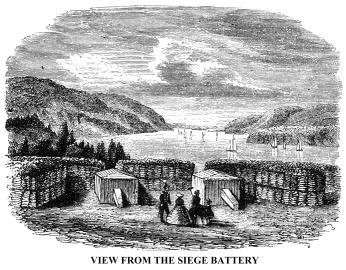 of
the hill just above.
of
the hill just above.
A little westward of the Siege Battery are the buildings of
the Laboratory of the institution, in which are deposited some interesting
relics of the old war for independence. One of the most attractive groups
among these relies was composed of several links of the great iron chain,
already mentioned, that spanned the river, enclosing a large brass mortar,
taken from the British at Stoney Point, by Wayne, and two smaller ones, that
were among the spoils of victory at Saratoga. There were a dozen links of
the chain, and two huge clevises. The links were made of iron bars, 2 1/2
inches square. Their average length was a little over 2 feet, and their weight
about 140 pounds each. The chain was stretched across the river at the narrowest
place, just above Gee's Point (the extreme rocky end of West Point) and Constitution
Island. It was laid across 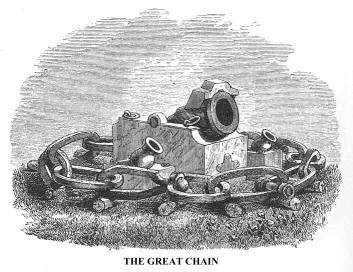 a
boom of heavy logs, that floated near together. These were 16 feet long, and
pointed at each end, so as to offer little resistance to the tidal currents.
The chain was fastened to these logs by staples, and at each shore by huge
blocks of wood and stone. This chain and boom seemed to afford an efficient
barrier to the passage of vessels; but their strength was never tested, as
the keel of an enemy's ship never ploughed the Hudson after the fleet of Vaughan
passed up and down in the autumn of 1777, and performed its destructive mission.
a
boom of heavy logs, that floated near together. These were 16 feet long, and
pointed at each end, so as to offer little resistance to the tidal currents.
The chain was fastened to these logs by staples, and at each shore by huge
blocks of wood and stone. This chain and boom seemed to afford an efficient
barrier to the passage of vessels; but their strength was never tested, as
the keel of an enemy's ship never ploughed the Hudson after the fleet of Vaughan
passed up and down in the autumn of 1777, and performed its destructive mission.
The views from Roe's Hotel, on the extreme northern verge of
the summit of the plain of West Point, are very pleasing in almost every direction.
The one northward, similar to that from the Siege Battery, is the finest.
Westward the eye takes in the Laboratory, Lieutenant-Colonel Wood's Monument,
a part of the shaded walk along the northern margin of the plain, and Mount
Independence, crowned with the ruins of Fort Putnam. Southward the view comprehends
the entire Parade, and glimpses, through the trees, of the Academy, the Chapel,
the Mess Hall, and other buildings of the institution, with some of the officers'
quarters and professors' residences on the extreme right. The earthworks of
Fort Clinton have recently been restored, in their original form and general
proportions, exactly upon their ancient site, and present, with the beautiful
trees growing within their green banks, a very pleasant object from every
point of view. The old fort was constructed in the spring of 1778, under the
direction of the brave Polish soldier, 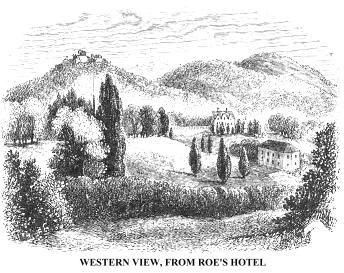 Thaddeus
Kosciuszko, who was then a colonel in the Continental Army, and chief of the
Engineers' corps. The fort, when completed, was 600 yards around, within the
walls. The embankments were 21 feet at the base, and 14 feet in height. Barracks
and huts sufficient to accommodate six hundred persons were erected within
the fort. It stood upon a cliff, on the margin of the plain, 180 feet above
the river.
Thaddeus
Kosciuszko, who was then a colonel in the Continental Army, and chief of the
Engineers' corps. The fort, when completed, was 600 yards around, within the
walls. The embankments were 21 feet at the base, and 14 feet in height. Barracks
and huts sufficient to accommodate six hundred persons were erected within
the fort. It stood upon a cliff, on the margin of the plain, 180 feet above
the river.
Copyright © 1998, -- 2004. Berry Enterprises. All rights reserved. All items on the site are copyrighted. While we welcome you to use the information provided on this web site by copying it, or downloading it; this information is copyrighted and not to be reproduced for distribution, sale, or profit.